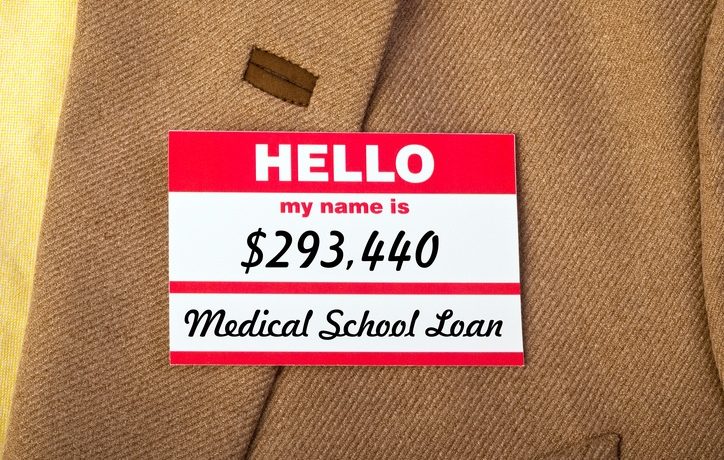medical school loans
5 Ways to Combat Physician Loans

The numbers are staggering.
More than 80 percent of all medical school students graduate with debt, according to the Association of American Medical Colleges. And, it’s not an insignificant amount; the median debt for all indebted medical school graduates in 2015 was $183,000.
That’s a tough sum to swallow after spending 12 to 15 years grinding away in school.
To make matters worse, paying back $183,000 in physician loans at 6 percent interest (which is pretty standard) can cost you about $2,000 a month and take more than 10 years–and include more than $60,000 in interest charges.
Those numbers can seriously cramp your lifestyle and keep you from realizing your financial dreams–especially if you don’t make wise financial decisions. The good news is that you can fight back against these staggering numbers and shorten the length of time it takes to pay down the debt.
Here’s a look at five ways to combat physician loans:
1) Start with a Signing Bonus
Many newly minted medical school graduates have often asked for and received signing bonuses. But, now that the country is in the midst of a physician shortage, the likelihood of receiving a signing bonus is better than ever–and the bonus is likely to be bigger than ever.
So ask.
It can be uncomfortable to ask for a signing bonus, but it’s worth it. According to Becker’s Hospital Review, the average signing bonus for physicians hired during the first half of 2015 (the last year for which figures are available) was more than $21,000. At the end of the day, any amount can help doctors address their physician loans.
2) Pay as You Earn
Many medical school students let their physician loans go into forbearance while they are in residency. Doing this allows the students to postpone making loan payments, but it does not stop interest from accruing.
However, there are programs that allow you to postpone interest capitalization while actually giving you an interest subsidy during the first three years you are making payments on your physician loans.
The income-based repayment program and the Pay As You Earn program both limit your payments to between zero and 10 percent of your overall income.
3) Refinance
It sounds so simple, because it is so simple. It can also save you an incredible amount of money. It’s refinancing, and it’s something you should constantly consider while you are paying back your physician loans.
Of course, refinancing only makes sense if you can lower your interest rate. So the first thing you should do when you graduate from medical school is figure out if refinancing your loan at a lower interest rate makes sense.
4) Find an Under-Served Area
Many states offer loan forgiveness and repayment programs for physicians willing to work in areas that are under-served by health care.
New Hampshire, for example, offers $75,000 toward physician loans to full-time primary care physicians who work in an area of the state that is experiencing a physician shortage for three years.
These programs are great ways for doctors to combat their physicians loans and gain valuable experience.
5) Live Within Your Means
After at least 12 years of education, many new physicians are in a hurry to realize the fruits of their labor. So instead of focusing on reducing their physician loans as quickly as possible, they buy expensive homes, cars and toys–and find themselves in even more debt.
Simply living within your means (and living in an area where the cost of living is low) is actually one of the easiest ways for you to combat your student loan debt.
—
Would you like to read more articles like this one? Subscribe!
![]()
Medical School Loans – Methods to Get Out of Debt Fast!

Success! You’ve completed medical school. With luck, you’re doing exactly what you want to be doing and life is good. Now, if you could only get rid of those medical school loans…
If you borrowed money to attend medical school, you know how onerous that debt load can be. In fact, median student loan debt for those who graduated in 2013 was $175,000 (including undergraduate studies but excluding interest). Compare that sum with the median debt of $13,469 in 1978 and you realize that your debt load seems like a heavy burden because it is a heavy burden.
A manageable monthly payment may be small comfort knowing that you’ll be making those payments for years to come. Fortunately, things might not be as grim as they appear. There are ways to get out from under the debt of your medical school loans faster than you might think if you’re committed to doing so.
Possessing the proper perspective is critical to carrying out the steps necessary to pay off your medical school loans as quickly as possible. Feeling guilty because you’ve incurred so much debt will not serve you. You are not alone. According to the Association of American Medical Colleges (October 2014):
- 79% of medical school graduates carry education debt of at least $100,000
- More sobering is the fact that 63% of med school grads owe at least $150,000 in education debt
- 86% of medical school graduates have at least some education loan debt.
Knowing that there’s nothing to be ashamed of, if ridding yourself of your education loan debt as fast as possible appeals to you, here are some steps that can help you do so:
Know your debt.
Take inventory of whether your loans are government issued, from private lender(s), or a combination of both. The nature of the lender may impact which debt management strategies are available to you.
Budget.
Seems obvious, but if you fail to follow basic debt reduction steps such as calculating what money you can make available to pay off your medical school loans, you’ll simply make the minimum monthly payment, precluding you from satisfying the debt sooner.
Pay more than the monthly minimum.
Most student loans agreements contain no prepayment penalty provisions. If yours does not, paying more than the minimum amount required will save you money and shorten the repayment period.
- For example, if you pay off a $30,000 loan with an interest rate of 4.5% over a 20 year period, you will end up paying just over $15,500 in interest in addition to the $30,000 principle amount. If, however, you pay that amount off in 10 years instead, you will only pay a little over $7,200 in interest.
Even a little bit helps.
That $5.00 you spend every morning on your favorite double whip, low fat, extra jolt coffee can make a difference over the months and years ahead.
FinAid.org offers an incredibly useful calculator that will help you “estimate the size of your monthly loan payments and the annual salary required to manage them.” Your lender may also help you calculate your options.
Consolidate your federal medical school loans. Making a single monthly payment at a fixed interest rate can help you strategize your payments and eliminate the vagaries of variable interest rates. This suggestion does not apply to loans with low fixed-interest rates. Further information is also available at studentaid.ed.gov.
Medical school loans are an example of “easy come, easy owe” – money easily borrowed at seemingly low interest rates. While it certainly adds up, you may be able to pay less and over a shorter period of time.
—
One other way to pay off your medical school loans is to find a job you love! If you are still searching for the perfect position consider Elliot Health System!
![]()





Recent Comments